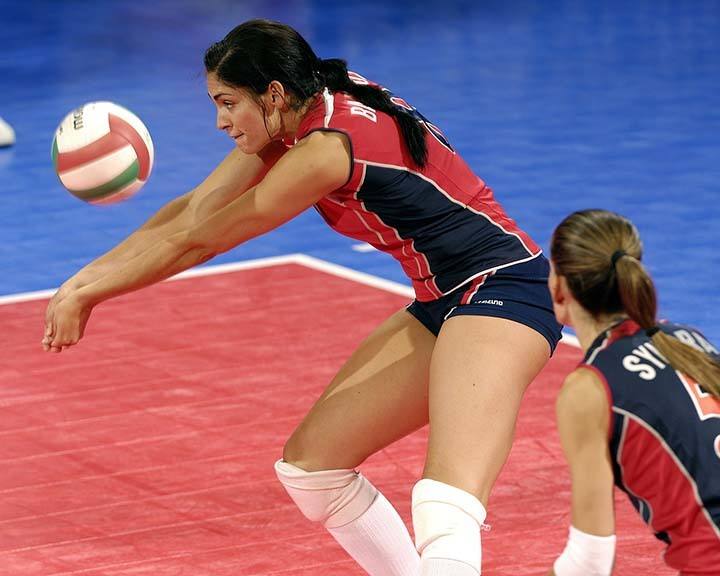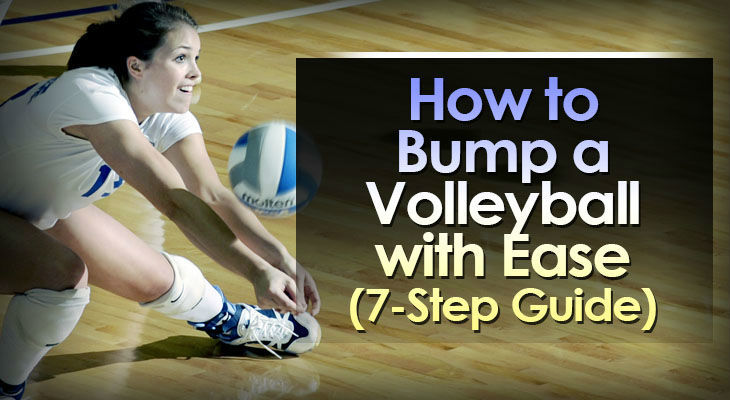How to Bump a Volleyball with Ease (7-Step Guide)
The underhand pass in volleyball has a common nickname…
The bump pass.
Also known as the forearm pass, it’s one of the key skills to learn as a young volleyball player.
A great bump passer can get the ball to a very select target and choose from a variety of trajectories to get it there.
Imagine being able to bump a volleyball into a basketball hoop from anywhere on the court…
That’s the level of skill the great forearm passers have.
Below, we’ll examine how you can bump a volleyball with ease!
Step #1 – Get to the Spot
It’s impossible to bump the volleyball accurately if you’re out of position.
Once the ball is headed toward you, get to a spot that allows you to be behind the ball before it arrives. Your hips should end up facing the target while keeping the ball in front.
Also, remember to move with your hands free…
Moving with your hands together in a bumping position slows your movement significantly and will result in you being out of place.
Instead, you should try your best to move in a ready position (knees bent, shuffling rather than turning and running, weight forward).

Step #2 – Position Yourself
The perfect bump starts with the perfect foundation.
And the foundation for your bump is your legs and hips.
Your hips should be facing your target, your weight should be slightly forward, and your knees bent athletically and shoulder width apart.
This platform allows you to aim the ball at your target (hopefully the setter’s hands), while maintaining a strong lower body support system.
Step #3 – Create Your Platform
The platform is the creation of a stable, even base with your arms to “bump” the ball from.
This base is created by bringing your wrists and forearms together to create a flat surface.
There are two types of platform for you to try, as each person prefers one style or the other based on her or his comfort level:
a. Hands together, one on top of the other facing up.
b. Ball one hand into a fist and wrap the other hand around it.
Regardless of which hand position you choose, you should aim to keep your platform as flat as possible.
Drawing your elbows in toward your body while keeping the hand and arm position will also keep things nice and flat.
Also, do not attempt to interlace your fingers while choosing a hand position.
This leads many to jammed or broken fingers and is an inefficient way to make a platform.
Pro Tip: Always bump from your forearms. If you make a habit of bumping the ball with the wrists or thumbs, you will quickly learn that this is the painful way of bumping a volleyball. Contacting the ball with the flat forearms created by the platform technique will allow you to pass and dig volleyballs free of pain and bruises!
Step #4 – Prepare for Contact
This is the point where everything should be aligned and ready to bump the volleyball.
Your platform should be flat, your shoulders and hips should be facing your target, your knees should be slightly bent, and you should feel strong in your lower body.
Step #5 – Get Low
Contact with the ball should occur around waist height.
However, you should not be reaching down to waist height to get to the ball.
This will result in you leaning forward and your platform will now be perpendicular to the floor rather than nearly parallel to it.
You should be lowering your body by bending your knees and hips, almost like you’re in a seated position.
Step #6 – Pass Through the Ball
Sometimes a bump will “drive” itself as the ball is coming with such force that it bounces off your platform quite firmly.
However, if this is not the case, you will have to provide some force of your own to your bump pass. This is not done by wildly swinging your platform up at the ball.
Rather, you should use your legs to thrust your torso toward your target while slightly moving your arms forward and up through the ball.

Step #7 – Get Reset
Once your bump pass is complete, you must reset to a position appropriate for your next play.
If you’re a back-row player, you should return to your athletic stance as quickly as possible to prepare to cover your teammates.
If you’re in the front row, you should be transitioning to your hitting approach to prepare for a possible incoming set.
What About Digging?
Digging requires all these steps you have just seen to be a good bump passer.
However, digging often requires more athleticism as this process is completed very quickly and at times while diving in one direction or another.
If you utilize these seven steps to perfect your bump, then you will be well on your way to be a great defensive player – including an impressive digger.
Conclusion
Learning how to bump a volleyball is essential if you intend to play at a high level.
It’s one of the most important skills you can have to ensure you can pass and keep the ball in play.
Following the seven steps above will guarantee that you have the necessary tools to give a great bump pass every time.
Now get out there and practice these steps – you can even bump against a wall if you don’t have a partner!

